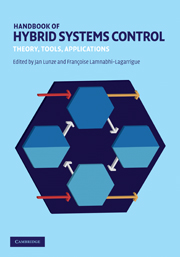Book contents
- Frontmatter
- Contents
- List of contributors
- Preface
- Notation
- Part I Theory
- Part II Tools
- 8 Overview of tools development and open problems
- 9 Verification tools for linear hybrid automata
- 10 Tools for modeling, simulation, control, and verification of piecewise affine systems
- 11 Modeling, simulation, and optimization environments
- 12 Interchange formats and tool integration
- Part III Applications
- References
- Index
12 - Interchange formats and tool integration
from Part II - Tools
Published online by Cambridge University Press: 21 February 2011
- Frontmatter
- Contents
- List of contributors
- Preface
- Notation
- Part I Theory
- Part II Tools
- 8 Overview of tools development and open problems
- 9 Verification tools for linear hybrid automata
- 10 Tools for modeling, simulation, control, and verification of piecewise affine systems
- 11 Modeling, simulation, and optimization environments
- 12 Interchange formats and tool integration
- Part III Applications
- References
- Index
Summary
To facilitate an integration of tools that have been developed separately and are based on different modeling approaches, an interchange format has been developed, which is described in this chapter together with the possible tool combinations that are enabled by this format.
Overview of interchange formats for hybrid systems
The purpose of interchange formats is to establish interoperability of a wide range of tools by means of model transformations. In this way, the implementation of many bilateral translators between specific formalisms can be avoided as shown in Fig. 12.1 and 12.2.
Work on interchange formats for hybrid systems has been carried out in different projects: in the MoBIES project, the Hybrid System Interchange Format (HSIF) is defined, and in an abstract semantics of an interchange format based on the Metropolis meta model is defined (this work is a continuation of the COLUMBUS project). Finally, in the HYCON network, two interchange formats have been defined: the interchange format for switched linear systems (Section 10.5) in the form of piecewise affine systems (PWAs), and the more general compositional interchange format (CIF), which is discussed in more detail in this chapter.
In HSIF, a network of hybrid automata is used for model representation. The network behaves as a parallel composition of its automata, without hierarchy or modules. Variables can be shared or local, and the communication mechanism is based on broadcasting of Boolean “signals,” where signals are partitioned into input and output signals.
- Type
- Chapter
- Information
- Handbook of Hybrid Systems ControlTheory, Tools, Applications, pp. 361 - 374Publisher: Cambridge University PressPrint publication year: 2009

